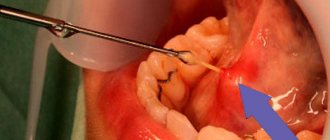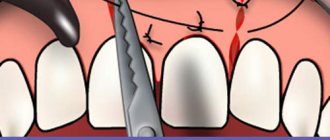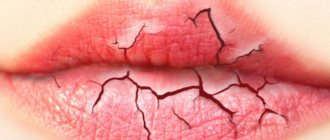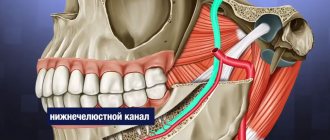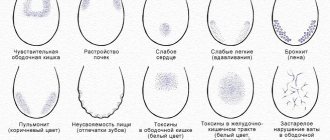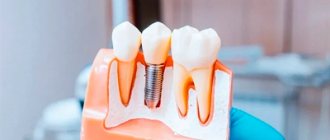Causes of sores in the mouth
Purulent ulcers in the mouth can appear for various reasons. They are often the result of dental diseases.
The list of reasons may include the following:
- viral infections (herpes simplex or herpes zoster);
- fungal and bacterial infections;
- irritation of the mucous membranes from smoking and certain foods (nuts, cheese, citrus fruits);
- ulcerative stomatitis;
- chemotherapy drugs;
- frequent stress and nervous tension;
- oral injuries;
- hormonal changes.
Complications after gum injuries
If you do not properly care for the oral cavity, as well as ignore a scratch on the gum, serious complications will always follow - infection in the scratched gum and the occurrence of an inflammatory reaction. How to understand that a complication has appeared?
- If a scratch has a whitish tint and its edges rise above the level of healthy tissue, this is a guarantee of a foreign infection.
- If the healthy tissues around the lesion are red and there is also swelling, this is evidence of inflammation (the body’s response to the introduction of a pathogen into a painful wound).
- If pus is released from a scratched gum, then an intoxication syndrome may occur in the body (fever, increased general weakness, increased pain in the mouth, a feeling of brittle bones).
- If there is a throbbing pain in the damaged areas, radiating throughout the jaw.
Cyst in the mouth of a child
If symptoms are detected, you should immediately consult a dentist, because the infected exudate from the scratch gets into the roots of the teeth and deep into the gums, causing local complications (stomatitis, gingivitis). Since the mucous membrane is supplied with blood, its flow causes the infectious process to become generalized.
How can you get rid of sores in your mouth?
How to treat wounds in the mouth if they appear and cause discomfort. Initially, you need to determine the true causes of their occurrence. This will help not only choose the right treatment, but also reduce the risk of relapse. If simply stomatitis has formed, it is not difficult to recognize it, but a purulent wound in the mouth of unknown pathogenesis is a reason to consult a doctor. Particular attention should be paid to lesions that do not heal for more than 10 days.
For a quick recovery, use:
- medicinal ointments with anti-inflammatory effect;
- antibiotics if the cause is a bacterial infection;
- complex of vitamins;
- rinsing with oral antiseptics;
- protective applications;
- painkiller injections;
- laser cauterization.
Causes of scratches on gums
The periodontal tissues and periosteum of the lower and upper jaw are in close contact with the mucous membrane of the gums. Mucosal tissue not only plays a protective function, but also serves as a conductor for metabolic reactions.
The tooth is nourished due to reliable blood supply and innervation in the gums, and any slightest damage will always result in a painful sensation. Thanks to this, the dentist can determine the location of the lesion and its parameters.
A scratch, be it a microcrack that is not visually visible, is a reason to seek specialized medical help. In the oral cavity (on the surface of the tongue, cheeks) there is a large amount of foreign microflora, which, if they get into the scratch itself, cause serious problems for the teeth and the body as a whole.
There are three reasons that cause gum damage:
- Mechanical factor - when the oral mucosa is damaged by hard food during eating (for example, when the gums are crushed with hard food: crackers, sweets, seeds) and during therapeutic measures (the gums are damaged during dental treatment - touching with a needle, drill, etc.). Mechanical damage (scratches) is more often caused by young children who carry unknown things to their mouths, gnaw or chew them.
- Chemical factor - when the mucous membrane is exposed to various chemical compounds (acids, alkalis).
- Thermal factor - ingestion of too hot food or water causes burns, and exposure to cold damages teeth.
One should take into account the fact that the mucous membrane becomes more susceptible when the human body’s immunity is reduced. Typically, this condition is caused by concomitant diseases: diabetes mellitus, HIV infection, benign and malignant neoplasms, sexually transmitted diseases.
In children
Since gum scratches more often occur in children who want to “taste” everything, their parents should carefully examine the oral cavity every day for the presence of such scratches. In children, the immune system is still weak and the protective mechanism in a small body may not work, and then a small scratch may be complicated by swelling and redness of the soft tissues around the lesion. Externally, the child will be restless due to soreness in the mouth.
The teenage generation has a high risk of bruises (street fights, football, bad falls). Vivid symptoms of damage include severe pain in the mouth, bleeding gums, a knocked out tooth, etc.
Scratch on the gum and possible complications
Infection of even a small scratch leads to swelling of the gums and the appearance of small bumps, causing discomfort when chewing. The tissue around the wound becomes inflamed, acquires a reddish tint and increases in volume.
Consultation with a doctor is required for the following symptoms of exacerbation:
- the appearance of swelling and a change in the color of the scratch to whitish;
- leakage of ichor or cloudy liquid;
- tugging or throbbing pain that spreads to other parts of the oral cavity.
These signs indicate that a purulent inflammatory process has begun. The infection can spread to the roots of the teeth, disrupting blood circulation, causing acute gingivitis, pulpitis or other complications.
In addition, inflammation is accompanied by constant pain, which interferes with eating, sleeping and disrupting normal functioning. The wound reacts especially acutely to the ingress of pepper, salt, and spices. All this can lead to the development of stomatitis and rashes.
That is why any scratch cannot be left unattended. It is necessary to immediately inspect the damaged area and treat it.
Treatment of scratches and wounds on the gums
What to do if you cut your gum? If the scratch is without foci of inflammation and other signs of complications, then you can get by with treatment at home using traditional medicine and the use of local antiseptics. Treatment of with chlorhexidine or furatsilin when rinsing promotes healing of the scratch and will become a serious obstacle to infection.
Treatment activities will include:
- drug treatment;
- folk remedies for wound healing;
- surgical care.
Drug treatment of injured areas
Many dentists do not advise self-medication and delaying consultation, especially when the child has cut the gum. At the stage of specialized care, the doctor will examine the surface of the mucous membrane, the nature of the cut in the gums and tell you how to treat it.
For difficult-to-heal mouth ulcers, dentists use ointments with an antiseptic effect :
- gel "Metrogil denta";
- gel "Cholisal";
- "Levomekol" (antibacterial agent);
- medicinal paste “Parodontocide”;
Metrogyl and Cholisal
For deep cuts, in order to prevent purulent infection, antibiotics :
- penicillin antibiotics (Amoxiclav);
- tetracyclines (Doxycycline, Tetracycline);
- tyrothricins (Grammidin).
Along with antibiotic therapy, anti-inflammatory treatment is indicated, including the use of non-steroidal anti-inflammatory drugs :
- Ketorolac;
- Nimesulide;
- Diclofenac.
This therapy is aimed at reducing the inflammatory response and pain.
A frequent question: “What to do when you scratch your gum, it’s swollen and you have bad breath?” If the gums are scratched and have an unpleasant odor, this indicates an infection in the mouth. If there is a complication, then surgical intervention , the purpose of which is to release pus from the scratch and then treat it with local antibiotics.
Folk remedies for wound healing
If the patient has scratched his gums, but does not want to seek medical help, a solution may be to take folk remedies that will quickly eliminate signs of inflammation and relieve tissue swelling.
- Dried St. John's wort in combination with flax seeds and oak bark will cope with an infection in the mouth. By killing the infectious agent, this decoction will restore beneficial microflora. Use 1 time per day for a week.
- Pieces of propolis relieve the inflammatory reaction. Used in alcohol infusion or made in the form of plates, attached to the inflamed area of the gums for 30 minutes. Use daily until inflammation disappears.
- Compresses with calendula have a similar effect to propolis.
- Using a solution of potassium permanganate to relieve inflammation, 2 times a day, for a week (especially for pulpitis, stomatitis, gingivitis).
Treatment of scratches in a child
Since children are susceptible to infection, self-medication is not the right solution. If a child exhibits the corresponding symptoms of gum damage, you need to contact a dentist to decide on further treatment measures.
Even a microcrack in children is an indication for consultation. The doctor will examine you and tell you how to treat the inflamed scratch.
Folk remedies
If you receive a wound on your gum, you should not wait for unpleasant consequences. It’s better to start preventing inflammation right away. To do this, it is not necessary to use powerful pharmaceutical antiseptics. It is enough to use simple recipes from traditional medicine based on herbal ingredients. They rarely cause side effects and do an excellent job with non-healing scratches on the mucous membrane.
The following formulations quickly and easily eliminate redness and burning due to infection:
- Calendula tincture diluted with plain water. The wound is thoroughly rinsed with it and applied as a compress to the jaw.
- A piece of propolis: it is used to prepare an alcohol infusion. A soft cake is also made from a natural component, which is left on the inflamed area of the gum for half an hour several times a day.
- Chamomile flowers and sage leaves mixed in equal proportions. From these plants you can prepare a decoction that will become an excellent antiseptic, help remove purulent contents and complement the main traditional treatment.
- A mixture of dried St. John's wort, oak bark and flax seeds will improve the microflora and remove the cause of infection in the oral cavity.
To speed up treatment, the patient will have to switch to soft or highly chopped food, and temporarily give up hot seasonings and sour pickled foods. The correct choice of hygiene products will help to avoid the recurrence of scratches on the gums: a high-quality toothbrush and toothpaste, rinsing solution. It is important to give up such a bad habit as smoking and increase local immunity, which will be able to resist any infection in the future.
What can the patient do after removal?
To help the wound heal, the patient must take steps to prevent secondary infection. To do this, immediately after the intervention you need to accurately follow the general recommendations of the dentist.
- Press the cotton swab placed in the hole firmly with your teeth. This is important to stop bleeding and blood clot formation.
- For the same reasons, you should not eat or drink for 3 hours.
- Once a clot has formed, it is necessary to exclude the possibility of injury and removal. Do not rinse your mouth vigorously, inspect the wound with your fingers or a toothpick, smoke, drink alcohol, hot foods and drinks, or solid foods.
- Visits to the fitness center, sauna, and beach should be excluded for several days. Physical activity and overheating can lead to complications.
Are there any complications?
Complications from gum graft surgery are minimal and uncommon.
However, it is possible that people may experience the following:
- bleeding gums
- swollen gums
- the teeth seem to wobble (although this should only be temporary)
- too sensitive teeth
- gaps between teeth
- infection
Sometimes the graft tissue may not attach properly to the graft site. This is very rare, but if it occurs, further surgery may be required.
Some people don't like the way their smile looks after surgery. In these situations, the periodontist can reshape the gums to help change the way they look.


